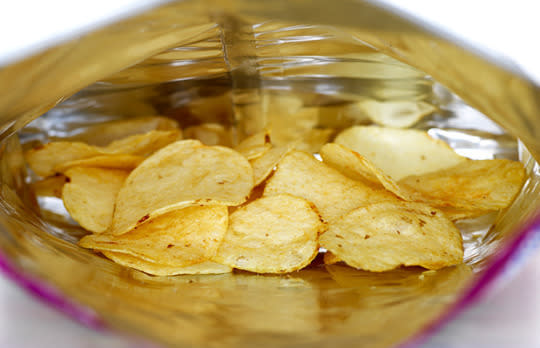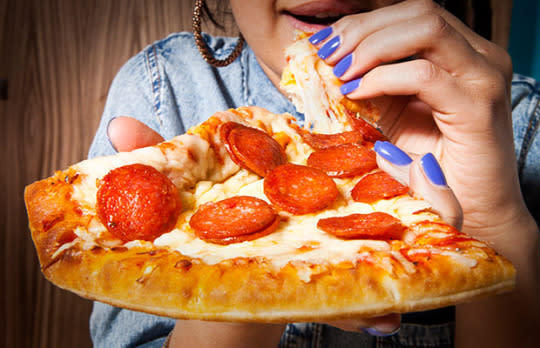The Foods You're Most Likely To Binge On--And How To Stop Overeating Them For Good

(Photo: Getty Images)
Ever been elbows-deep in a jumbo bag of potato chips, telling yourself just a few more, but stopping when only crumbs remain? Ever baked a pan brownies and shaved just a few millimeters from the edge every time you walked into the kitchen? Ever go to the movies and just had to get buttery popcorn? It’s not your fault (really!)—some foods legitimately make us lose control. We like to call these trigger foods … And they suck. But the first step in breaking their hold is understanding why they hypnotize us in the first place.
Related: 3 Pressure Points That Can Stop Binge Eating

(Photo: Getty Images)
For starters, it’s basically encoded in our DNA to binge on salty, fatty, and sugary foods, or on various combinations of the three. Back in the day, foods with high levels of these nutrients (and ergo, lots of calories) were rarely found in nature, so when our hunter-gatherer ancestors discovered them, they ate them to completion to ensure they wouldn’t, you know, die of starvation later. (Lose up to 15 pounds WITHOUT dieting with Eat Clean to Get Lean, our 21-day clean-eating meal plan.)
Unfortunately, that same instinct now primes us for binging on junk, says Gary Wenk, PhD, author of Your Body on Food. Whenever you eat super sugary, salty, and/or fatty foods, the dopamine neurons in your brain become very active, producing feelings of pleasure that encourage you to “eat that again!” These also happen to be the neurons that are activated after someone takes cocaine or meth. Yikes, right? That makes those brownies legitimately addicting. (Stop a binge before it starts with these handy tips.)

(Photo: Getty Images)
But what are the absolute biggest trigger foods? Foods that combine salt, sweet, and/or fat, like pizza (salt-fat), donuts (sweet-fat), and peanut-butter pretzels (sweet-salt-fat) will lead to the most cravings and tendency to overeat, says Wenk, noting that these flavors work synergistically to enhance each other’s addictive properties.
Related: 10 Slimming Smoothie Recipes
How to break free? The key is to snack on something that captures the essence of what you’re craving, but that’s far less addicting—that is, the food doesn’t combine high levels of sugar and fat or salt and fat (or all three). That might mean opting for plain roasted nuts over salted and roasted nuts, apples sautéed in a little coconut oil instead of apple pie, a square of 70% cocoa dark chocolate instead of a half a sheet of double fudge brownies, or a coffee with almond milk and a dash of cinnamon instead of a pumpkin spice latte. These help at least partially satisfy the itch without setting you off on a junk food bender.
Related: 10 Snacks Every Stress Eater Needs
One thing to take comfort in: Our brains are very plastic, or adaptable to change, and learn to crave the molecules they’re exposed to on a daily basis, says Wenk. In other words, the more you make you’re new healthy snacks a habit, the more you’ll crave them and the less you’ll fall victim to drug-like trigger foods.
By Stephanie Eckelkamp
This article ’The Foods You’re Most Likely To Binge On–And How To Stop Overeating Them For Good’ originally ran on Prevention.com.
More from Prevention:
